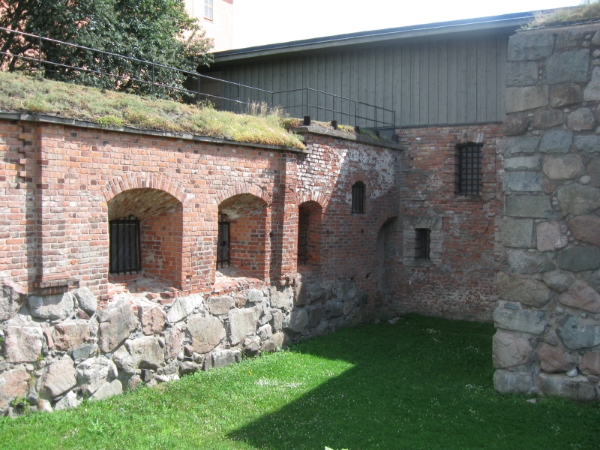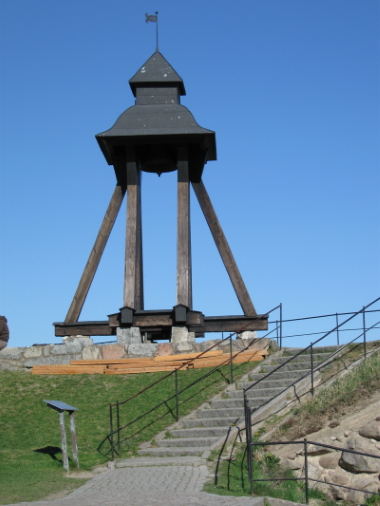Uppsala Slottet (The Castle)
Built on a ridge overlooking the city, the large pastel-pink Uppsala Castle is easily seen when you approach Uppsala. As well as going into details about the castle, it would be helpful to include the people who helped to define its history. It was King Gustav Vasa, who ordered the castle to be built in 1549.

S. Pathkiller 2007, Uppsala's castle, CC
Gustav Vasa is acknowledged as the first native Swedish king who formed a sovereign state, although at that time the country was really divided between different kingdoms and rulers. After years of war with Denmark, a triumphant Gustav Vasa was elected king on June 6th, 1523, now the Swedish national day. It was five years later before he was officially crowned in Uppsala Cathedral.
The king’s reign was not without strife and he fought off a number of rebellions in different areas of Sweden. The ruling powers had historically been very closely affiliated with the Catholic Church. However, the new king expelled the archbishop who he believed was allied with the Danes and appointed his own against the wishes of the pope. Under King Gustav Vasa’s reign, the Lutheran religion gained popularity and the pope eventually lost all influence over the church in Sweden.
The king was married three times during his life and is buried in Uppsala Cathedral with two of his wives. His first marriage produced one son, Erik XIV and after her death Vasa remarried and had 10 children with his second wife. The oldest son from that marriage was Johan III and the youngest son was Karl IX. The descendants of Vasa played key roles in the historical events at Uppsala's Castle.

S. Pathkiller 2007, Canons just happened to be pointed towards the cathedral, CC
Standing on the castle grounds today will provide you with a fantastic view of the city. That view was part of the strategy behind the placement of the citadel, which was intended by Vasa, at least partly, as a fortress to defend against enemies. It is ironically noteworthy that the canons lined up in front of the castle seem to be pointed directly at the Cathedral, suggestive of the historical power struggle between the church and the state.
Over time, Vasa’s sons expanded and reshaped the fortress into a renaissance style palace. The state hall within the castle was used as a site for meetings and royal festivities after the coronation ceremony in the Cathedral.

S.Pathkiller 2009, Outside the castle dungeons, CC
The castle has also witnessed its share of unhappy events. In 1567, Erik XIV, who was Sweden’s king until he was deposed, had become mentally unstable and had his half-brother Johan III imprisoned in Gripsholm Castle. In his delusional paranoia about being plotted against by the aristocracy, he captured three members of the very influential Sture family and imprisoned them in the dungeon at Uppsala. Before the nobility could decide their fate, the king and his guards murdered them in the night. In less than two years the king ordered Johan III to be released, but his madness had progressed to the point where a rebellion was organized. Erik XIV was overthrown and Johan III was proclaimed king.
Move forward in time 60 years and the throne belongs to King Gustav II Adolf. It was from Uppsala Castle that the king, who became known as the Lion of the North, announced that Sweden would join the Thirty Years War fighting on the side of the Protestants. In fact the king’s reign was dominated by warfare and Sweden rose during this time to become one of the great powers of Europe. Sweden’s territory expanded until it was the third largest nation in Europe after Russia and Spain. The king died in battle, leaving the throne to his then six-year-old daughter Kristina.

S.Pathkiller 2009, Gunillaklockan (Gunilla’s bell)
was donated by Queen Gunilla in 1588, refurbished in 1759, CC
Queen Kristina ruled the nation until June 5th, 1654 when her wish to abdicate was accepted. She had secretly become a Catholic and wanted to pursue her religion freely and therefore decided to give the crown to her cousin, Karl X. The ceremony was held in the State Hall of the Uppsala Castle. During the ceremony Kristina wore the full regalia, which were removed from her piece by piece until nothing was left but the crown. Dressed in a white taffeta gown, she removed her crown and gave her farewell speech. She later left the country, fleeing to Rome, where she is buried.
In 1702 the great fire that destroyed so much of Uppsala also had an impact on the castle. Efforts were made to rebuild it, but it was a slow process, especially when stones from the building were appropriated to use in the Royal Palace in Stockholm. The castle was eventually rebuilt in a French classical style, with a north wing planned, but never finished due to lack of funding.

S.Pathkiller 2009, Castle entrance to the Art Museum, CC
Today Uppsala castle is used as a residence by the governor of Uppland County. Official visitors are received in the apartments while the room in the north tower is used for conferences. Dag Hammarskjöld, the former Secretary-General of the United Nations spent a good deal of his childhood at the castle while his father Hjalmar served as governor. In addition to being the Governor’s living quarters the castle has office space available to rent, and also houses the Uppsala Art Museum and down in the castle dungeon is Vasaborgen (Waxworks Museum).
On display in the art museum is Uppsala University’s collection of fine art, plus works of art from its own collections and various exhibitions. The majority of artwork comes from Holland and France and is displayed by genre: still life, portraits and landscapes from the 16th century. However, there are also paintings from the 20th century done by Swedish artists and contemporary works purchased through the years.
In addition to the paintings and prints there is a display of ceramics from the Uppsala-Ekeby tile factory, which was the largest tile maker in Scandinavia in the early 1900s, but ceased to operate in 1977. In the dungeon there are period characters sculpted of wax which are meant to bring to life scenes from the Renaissance period.